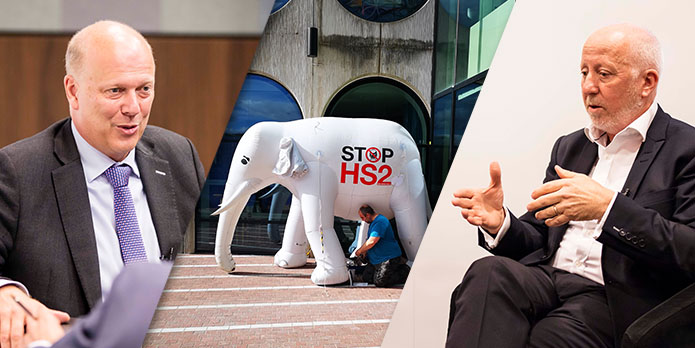
Smoke and mirrors, Swiss cheese and sagging elephants
Freshwater’s John Morris discusses rail in the context of this autumn’s political party conference season
For rail industry watchers this autumn’s party conferences may have been a confusing time, for it is often what goes unsaid that triggers the concerns of more inquiring minds.
Labour’s ideological preference, of a nationalised railway, gained a lot of air time at its conference in Liverpool. Yet, there are some fundamental issues still to be resolved. Although “Bring Back British Rail” can be a powerful rallying cry, with strong play on the doorstep, the shadow transport secretary, Andy McDonald, sought to allay industry concerns that his party actually does want to recreate British Rail. It is far from clear which parts could be revived into public ownership and where the line would be drawn: how far down a fragmented supply-chain would Labour go? What difference would further public ownership actually make to customers, whether passengers or freight operators?
As is often said, Network Rail is, in effect, already in public ownership. Arguably, a large part of Labour’s aspiration has thus been achieved. However, Network Rail has shouldered a large part of the responsibility for the May 2018 timetable change fiasco. The interim report of the Office of Rail and Road’s (ORR) chairman, Stephen Glaister, concluded that Network Rail, Govia Thameslink Railway (GTR), Northern, the Department for Transport, and the ORR all made mistakes. Meanwhile, the person who many might assume to be the closest to someone ‘in charge’ – the transport secretary, Chris Grayling – consistently argued at conference that his approach – forming an expert advisory group and taking its advice – means he should not be held responsible for the timetable’s failure.
While Network Rail’s senior directors have talked about a bulked up ‘System Operator’ as a way of providing the strategic oversight needed in a fragmented and increasingly devolved system, this is not quite the same as a single ‘controlling mind’ and the ongoing absence of this plays into the Labour narrative that the present railway cannot be effectively controlled and should be consolidated by taking passenger operators into public ownership.
So far, so good, but as soon as freight was mentioned in the conference fringes, compelling answers became rather more difficult to provide. Andy McDonald reminded audiences that a state-owned freight company – DRS – already exists and suggested that DRS could therefore pick up the business of any ‘failing’ rail freight company. However, he remained less clear on whether any of the companies could be purposefully nationalised.
Rolling stock operators (ROSCOs) is another awkward subject for Labour. As the travelling public’s main interface with the railway is riding on trains leased to operators by ROSCOs, it seems anomalous that there appears to be no definitive Labour policy to take that critical element into public ownership.
This, of course, is where the ‘realpolitik’ of rail transport is best concealed by smoke and mirrors. It is a hugely expensive undertaking and to acquire all of the key assets may be a step too far for a Labour government. Given the asset base involved, it remains to be seen how rolling stock ownership and freight plays into Labour’s ambitions.
And, just in case you thought the sleight of hand was confined to Her Majesty’s Opposition, it is worth taking a look at the goings-on in Birmingham, at the Conservative’s conference.
Back in May, Chris Grayling pronounced that the government “is committed to empowering regions across the UK by giving them a stronger influence over the future of transport in their area”. Transport for the North has long-harboured a desire for the powers enjoyed by Transport for London and may have held out a hope for a significant announcement at conference to bring this vision closer. Alas, it was not to be. Despite some extra money in the budget, and while TfN attracts very strong support from regional stakeholders, there is still a suspicion that the ‘powers that be’ at the national level are reluctant to let go of central oversight and control to fully empower sub-national transport bodies.
On 20 September, Grayling announced “a sweeping review to transform Britain’s railways” and during party conference he was unequivocal in his conviction that the “current franchising system is broken”. Yet discussions in fringe meetings suggested that he does not believe franchising is broken beyond repair: he told one session that his Rail Review was intended to provide “external validation” of his department’s existing approach. It might ask it to speed up reforms but it will not fundamentally re-write government policy.
The industry made its voice heard at the conferences and the (now former) rail minister, Jo Johnson, was very much in ‘receive mode’. He attended several industry events and, at one, was given the message that the ‘Swiss cheese’ nature of rail electrification pretty much made his aspiration for diesel-only trains to be withdrawn by 2040 unlikely to be realised.
Although bi-mode locomotives are useful for branch lines and ‘last mile’ operations, fast and heavy freight trains need serious horsepower in the form of diesel or electric traction. The lack of ‘fill in’ electrification means that operators poised to renew or supplement fleets are increasingly unlikely to invest in electric traction – locking in the use of diesels on certain routes well after 2040.
Whilst a lot of the lobbying outside the conferences was Brexit related, the ability of the Stop HS2 campaign to keep going has to be admired. Its inflatable white elephant has been a fixture for many years. On HS2 Grayling was at his most assertive: “it is already happening now” was a mantra exasperatedly repeated on several occasions.
Freshwater is a full-service corporate communications and public relations consultancy with over a decade’s experience advising organisations in the rail sector. To get in touch, email hello@freshwater-uk.com or call 020 7067 1595.
A version of this article was originally published in the November 2018 edition of Rail Professional magazine.
